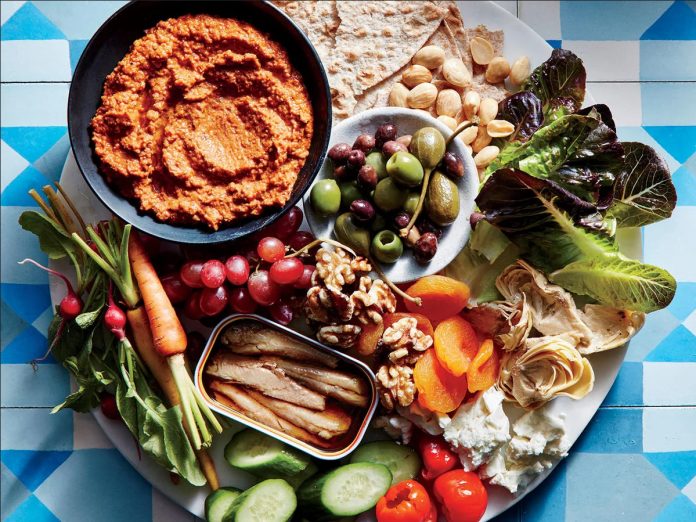Fad diets get their fair share of (well-deserved) flack, but when it comes to the medical literature, there doesn’t seem to be much controversy over a Mediterranean-style diet. Rather than a rigid plan, the Mediterranean diet is more like a mash-up of cuisines from the countries that surround the Mediterranean Sea, but they share a few qualities that studies show make it a heart-healthy and waistline-friendly diet.
The Mediterranean diet is known for lots of colorful fruits and vegetables, fish and seafood, whole grains, and monounsaturated fats like nuts and olive oil. It limits sugar and processed foods, along with saturated fats like red meats, dairy, and poultry.
A 2013 study in European Journal of Cancer Prevention found evidence that this combination of foods increased longevity in participants and reduced the risk of heart disease and certain cancers, and it may help prevent and treat type 2 diabetes, according to a 2014 study in Diabetes/Metabolism Research and Reviews. It may also improve cognitive function in older populations due to the monounsaturated fats, based on a 2015 study in JAMA Internal Medicine.
We all wish we could pack our bags and move to Naples or Santorini, but the truth is it’s easy to add a little Mediterranean flair to any meal, even those in regular rotation on your home menus. Here’s how:
- Flavor with herbs. Cooking with herbs like basil, cinnamon, coriander, oregano, and dill can help you cut back on the salt, sugar, and fat that commonly adds up in our food, according to the American Diabetes Association. Another great option? A little citrus, like a squeeze of lemon juice or a little orange zest.
- Add fresh greens to pizza. Here’s how make your pizza more of a health food. After baking, toss fresh arugula or baby kale on top of your pie. Not only does it up the flavor, but it also adds a vibrant color contrast to your typical red pie. Try it out: here’s an artichoke arugula pizza that you’ll totally forget is healthy.
- Embrace the bean.Mediterranean recipes often include beans, which provide a healthy dose of fiber and protein. Add chickpeas or cannellini beans to your salad or in pasta. You can even add crunch to your salad by adding roasted chickpeas. (Learn how to make your own spiced and roasted chickpeas here.)
- Make half your plate roasted vegetables. Go-to veggies in the Mediterranean cuisine include eggplant, mushrooms, artichokes, potatoes, and tomatoes. (Fine, that last one is technically a fruit, but it’s still excellent for roasting.)
- Make tzatziki your condiment of choice. This simple sauce is made from plain yogurt, diced cucumber, minced garlic, and fresh herbs, like dill. Add it to your wraps and sandwiches, use it as a dip for carrot sticks, or even dress a Greek salad with it. Think of it as a healthier cousin to ranch dressing, and the possibilities are pretty endless.
- Add bean spreads to sandwiches. Whether you stick with classic hummus or venture into the other beans, this is an easy way to add flavor and protein to a sandwich. FYI, you can make a hummus-like spread out of nearly any bean, so experiment with white beans, edamame, and more. (Here’s how to make hummus at home.)
- Try pine nuts. The Mediterranean diet makes use of all types of nuts, like walnuts and pistachios, but pine nuts are so easy to add to savory dishes. They’re good raw or toasted; just toss them in your salads or in sauteed greens.
- Add seafood to pasta.Instead of adding ground beef to your marinara or chicken to your pesto, try shrimp, scallops, or mussels. (Here’s how to pick out the best fresh mussels from the store.)
- Give new grains a chance. You’ve probably tried brown rice already; now give lesser known grains like bulgur, farro, or whole wheat couscous a shot. (Technically, couscous is a pasta, not a grain itself.)
- Prepare foods with olive oil.A word of caution: even though olive oil contains the good-for-you monounsaturated fat, it’s still an oil that’s rich in calories and fat, so you need to be mindful of how much you’re eating throughout the day. Also, extra virgin olive oil is not meant for high-heat cooking, so switch to avocado oil for your saute needs.
- Add eggplant—to everything.This versatile veggie soaks up whatever flavor you add it to, so it can go in virtually anything. Dice it up into one-inch cubes, saute until soft, and add to pastas, stews, and casseroles. (Learn how to make eggplant chickpea stew here.) You can also roast or grill in oblong slices and add to your sandwiches.






























